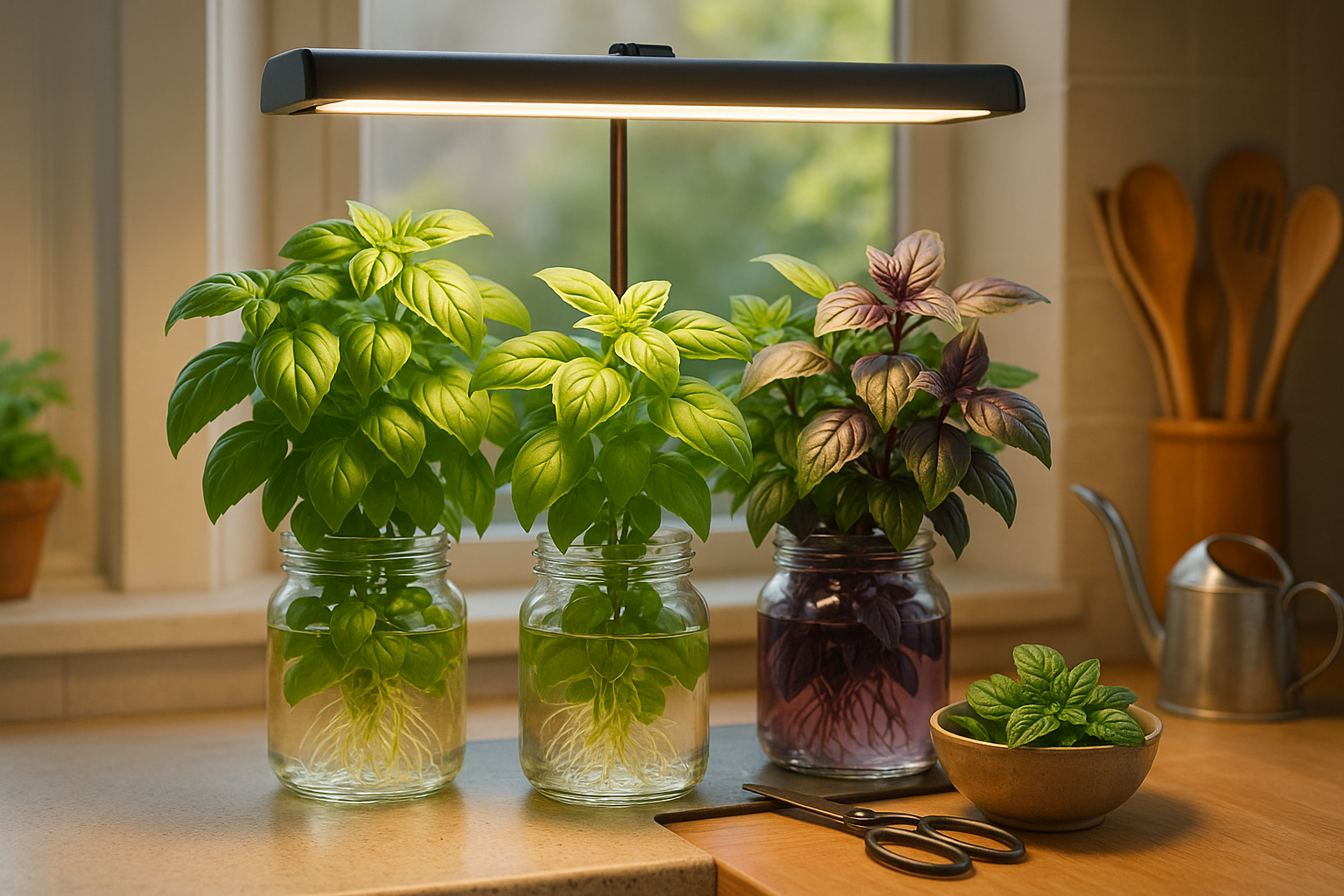Why Grow Basil Hydroponically?
Basil is a go-to herb for home cooks and gardeners alike, famous for its sweet aroma and versatility in dishes like pesto, pastas, and salads. If you want to get the most out of this beloved plant, growing basil hydroponically is a smart move—especially for a steady, reliable supply right from your kitchen.
Hydroponic systems allow basil to grow faster than in soil because nutrients are delivered directly to the roots in a controlled environment. This means you can expect plumper leaves, richer flavor, and increased yields in less time.
Another big win is fewer pests and diseases, which are common headaches in traditional gardening. With no soil to harbor insects or fungal spores, your basil has far less to fend off, making maintenance easier and reducing the need for pesticides.
Plus, hydroponic setups are incredibly space-efficient, letting you grow basil indoors year-round—even in small apartments or cold climates. When it comes to taste, many hydroponic gardeners report that the flavor and fragrance of their basil are just as good, if not better, than soil-grown plants, since the controlled environment allows you to fine-tune growing conditions for optimal results.
There’s also a convenience factor: hydroponics means no messy dirt, less weeding, and fewer watering worries—just clean, robust plants at your fingertips whenever you need them.
If you’re after a practical, enjoyable way to harvest fresh basil regardless of the season or your living situation, hydroponic gardening offers a compelling alternative to traditional methods, combining higher productivity with less hassle and consistently delicious results.
Choosing the Best Basil Varieties for Hydroponics
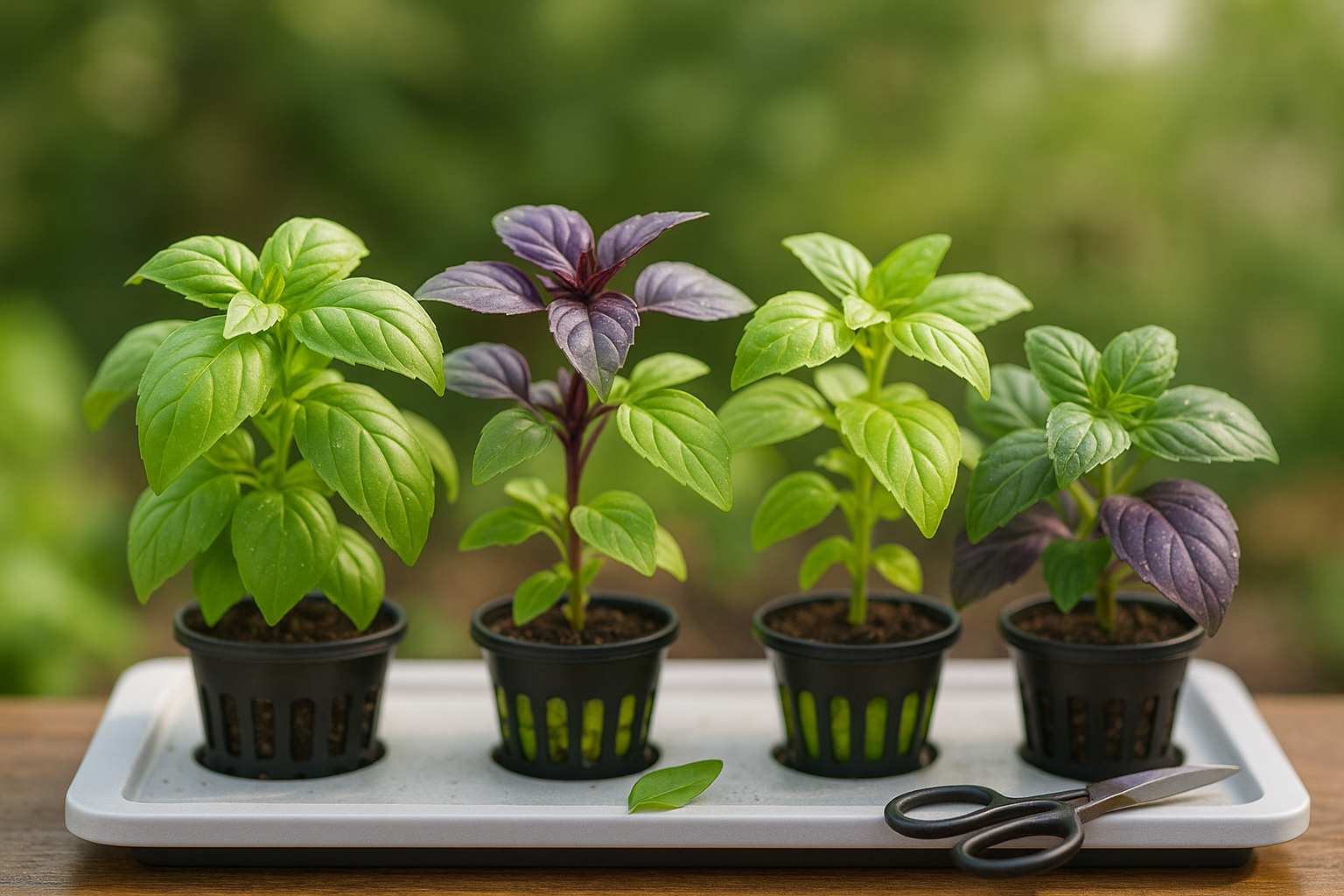
When it comes to hydroponic gardening, choosing the right basil variety can make all the difference in your harvest. Genovese basil is the classic go-to for Italian dishes — its large, fragrant leaves thrive in hydroponic systems, producing robust yields perfect for pesto and Caprese salads.
Thai basil, with its purple stems and spicy, anise-like flavor, brings unique flair to stir-fries and curries. It also grows compactly, making it a smart pick for smaller systems. Lemon basil stands out with its bright, citrusy aroma — a refreshing twist for teas, salads, or desserts — and grows rapidly under well-controlled hydroponic conditions.
For something visually striking, Purple basil adds color to both your indoor garden and your plate. While it’s a bit slower-growing, its mild, peppery taste pairs well in salads or as a garnish.
When choosing which variety to grow, consider your favorite dishes and how much space you have. Compact or bushy types like Thai and Lemon basil do well in tight spaces, while larger varieties like Genovese might need more room.
Always purchase seeds or seedlings from reputable hydroponic supply stores or organic seed companies. Look for those labeled “hydroponic suitable” or “disease-resistant” for the best results. Many online retailers, like Johnny’s Selected Seeds, Baker Creek, or your local hydroponics shop, carry a diverse range ideal for soilless cultivation.
Whichever variety you pick, fresh homegrown basil will elevate your meals and bring fragrant life to your indoor garden.
Setting Up Your Hydroponic System for Basil
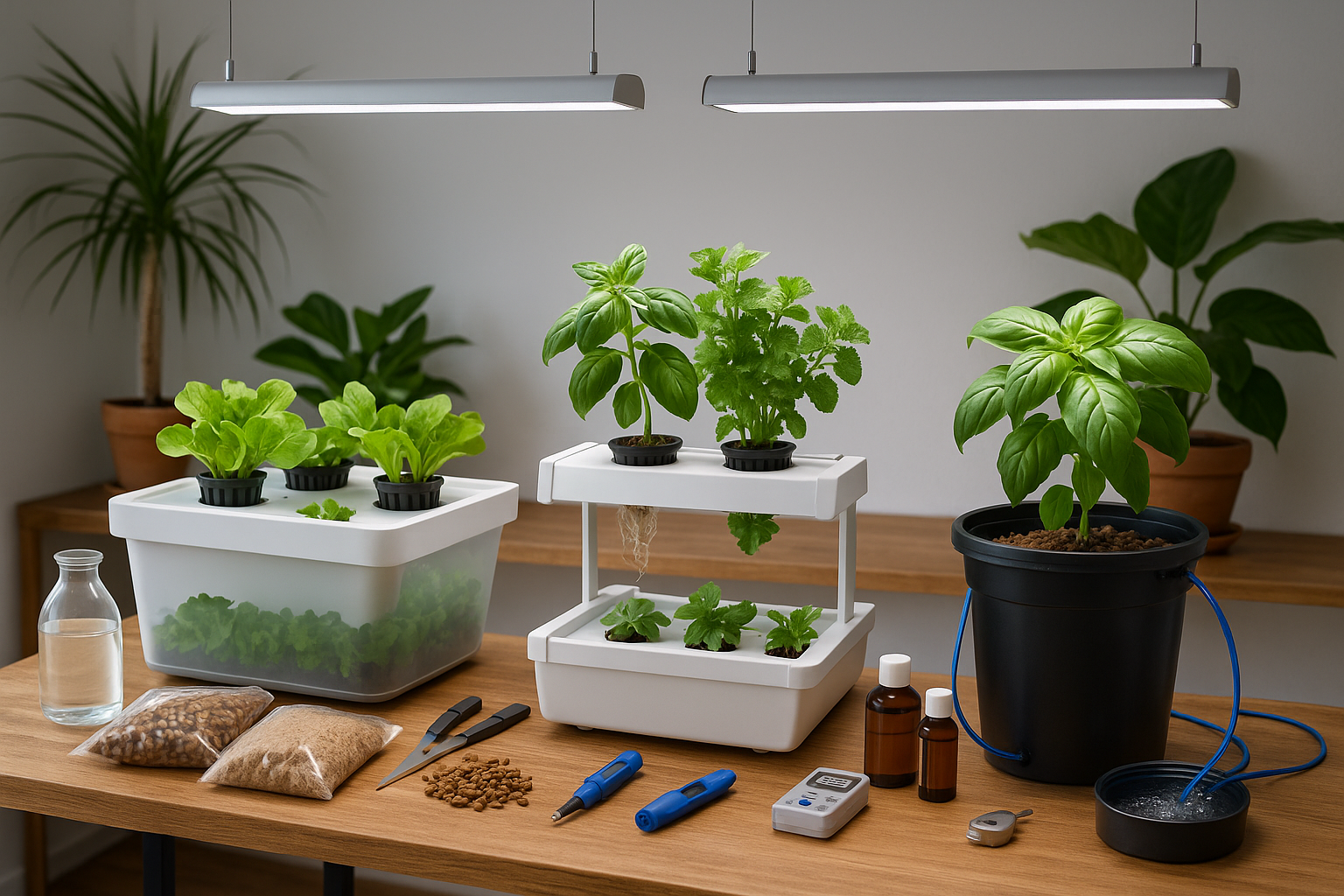
Starting your own hydroponic basil garden is easier than you might think, especially with a variety of systems to fit different needs and spaces. The Kratky method is a low-tech, passive setup perfect for beginners looking for a no-fuss start—you simply fill a container with nutrient solution, suspend your basil in net pots, and top up the water as needed.
For more robust growth, consider Nutrient Film Technique (NFT) or Deep Water Culture (DWC). NFT uses a shallow stream of water to provide roots with nutrients and oxygen, while DWC keeps the plant roots suspended in a constantly aerated nutrient bath. Both methods are great for continuous harvests and higher yields.
Ebb & flow systems (also called flood and drain) work well if you prefer some automation, using a timer to periodically flood the plants with nutrients and then drain the solution away.
Whichever system you choose, you’ll need some basic gear:
- A reservoir for your nutrient solution
- Quality grow lights (LEDs are efficient, and basil loves 14–16 hours of light daily)
- Net pots or cups to support your plants
- A growing medium like clay pebbles, rockwool, or coco coir to anchor roots and retain moisture
When setting up your garden at home, pick a site that’s easy to access, away from drafts and direct heat sources, and maintains a stable temperature—basil thrives between 70–80°F. Avoid areas with potential contaminants like garages or laundry rooms, which can harbor chemicals or dust. Also, ensure your system sits on a sturdy, waterproof surface.
For safety and easy maintenance, always unplug electrical equipment before cleaning or making adjustments. Check your equipment weekly for issues like clogged tubing, algae buildup, or pump malfunctions.
Keep nutrient solutions fresh by changing them every two weeks and regularly check the pH level (basil prefers 5.5–6.5). When starting out, label all hoses and timers, and keep instructions handy so you’re never lost during troubleshooting.
With a little preparation and these common-sense steps, your hydroponic basil garden can provide fragrant, lush harvests right in your own home.
Starting Basil from Seed
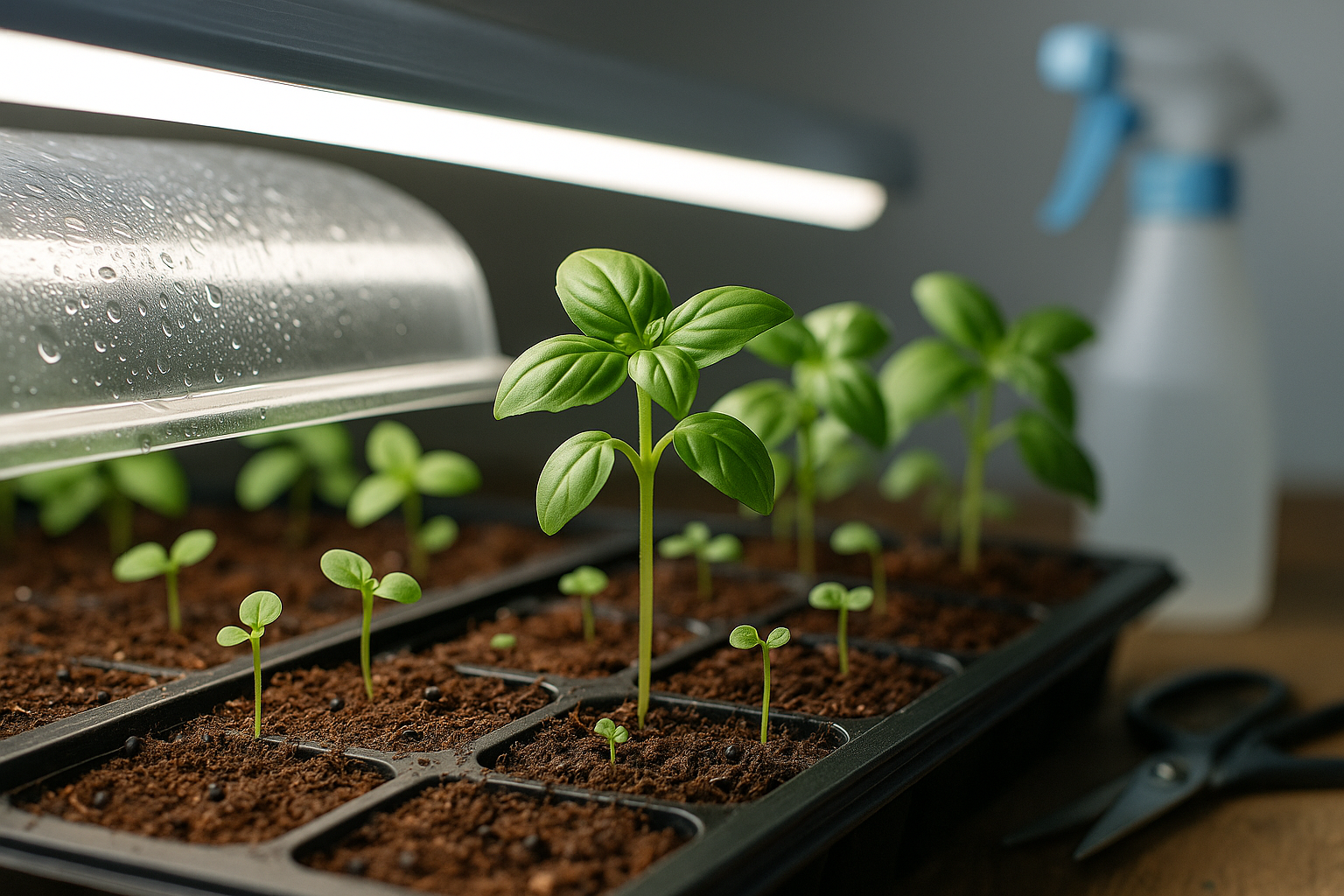
Starting basil from seed is simple, but a little upfront preparation goes a long way. Begin by choosing a sterile, well-draining germination medium—coco coir, peat pellets, or a high-quality seed starting mix work well. Moisten the medium so it’s damp but not soggy, as basil seeds need consistent moisture to sprout but can rot if waterlogged.
Use shallow trays or seedling plugs, and sow the seeds about ¼ inch deep. Cover lightly and place the tray in a warm spot—between 70–75°F (21–24°C) is perfect for quick germination. Basil seeds don’t need darkness to sprout, so provide gentle light—either a bright window or fluorescent grow lights placed a few inches above the tray. Expect to see sprouts in 5–10 days.
Keep humidity high by loosely covering the tray with plastic wrap or a humidity dome, and mist frequently to avoid drying out. Once seedlings develop two sets of true leaves (usually 2–3 weeks after sowing), they’re ready for hydroponic life.
To transplant, gently lift each seedling by the leaves—never the stem—to avoid bruising, and rinse off soil or media from the roots using water. Place each seedling into net pots with hydroponic substrate such as clay pebbles or Rockwool, ensuring roots are hanging freely. Move quickly so roots don’t dry out.
Common Pitfalls
- Overwatering, which causes damping-off and rot
- Poor air circulation, leading to mold
- Sowing seeds too deeply, which delays germination
If you notice stems collapsing or fuzzy growth, reduce moisture, increase airflow, and consider a gentle antifungal spray. With attention to moisture, warmth, and gentle handling, you can go from seed to thriving hydroponic basil in just a few weeks!
Ideal Growing Conditions and Ongoing Care
To help your hydroponic basil thrive, it’s important to dial in the foundational growing conditions. Start with the root environment—basil prefers a slightly acidic pH of 5.5 to 6.5, which helps prevent nutrient lockout and supports strong root growth. Electrical conductivity (EC) is equally vital; aim for a range between 1.0 and 1.6 mS/cm to provide the right balance of nutrients without overwhelming the plants. Water temperature should hover between 18°C and 24°C (65–75°F); water that’s too warm can lead to root rot, while cold water stunts growth.
When choosing a hydroponic nutrient mix for basil, select formulas designed for leafy greens or specifically for herbs. Look for a balanced NPK ratio (preferably around 2-1-2), and make sure the solution includes trace elements like magnesium, calcium, and iron. Rotate or completely change out the nutrient solution every two weeks to keep it fresh and well-balanced—this prevents deficiencies that can impair growth and flavor.
Lighting is another cornerstone for lush, aromatic basil. Basil needs about 14–16 hours of light per day, so use a digital timer to maintain a regular schedule. LED grow lights are ideal as they deliver full-spectrum light while staying energy-efficient and cool; fluorescent lights are also a solid budget alternative. Position lights 12 to 18 inches above the basil canopy, adjusting as plants grow taller to prevent scorching or stretching.
In terms of care, keep up with routine pruning once true leaves have developed; this encourages bushier growth and prevents flowering, which can make leaves bitter. Use clean, sharp scissors to snip just above a node (where leaves meet the stem), and remove any yellow or drooping leaves early. Regularly inspect plants for early signs of pests like aphids or whiteflies, especially around stems and leaf undersides, and address issues promptly with organic pest control like neem oil or insecticidal soap.
Watch for diseases such as root rot and downy mildew—keeping your water and air flowing with adequate circulation helps prevent many issues before they start. Lastly, always keep an eye on your hydroponic system’s reservoir; top up with fresh water as needed, and wipe away any algae buildup. A little daily attention goes a long way to ensure your hydroponic basil stays healthy, vibrant, and full of flavor for all your culinary needs.
Harvesting Basil and Extending Your Crop
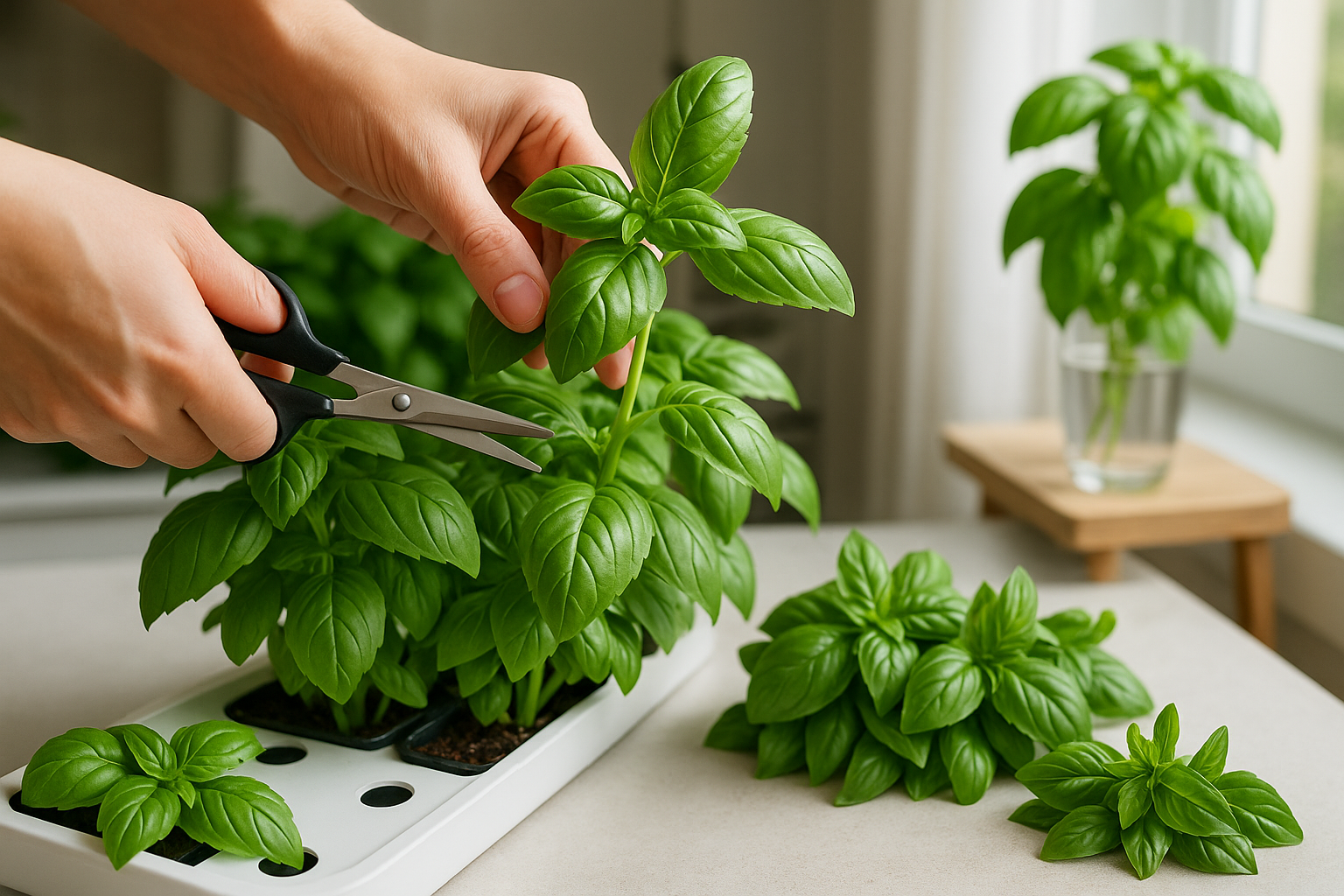
Harvesting basil at the right time is key to enjoying the freshest flavor and keeping your plant productive all season long. For the best taste, pick basil leaves in the morning after the dew has dried but before the midday sun, when the essential oils are most concentrated.
Use sharp scissors or your fingers to pinch off the top sets of leaves, just above a pair of healthy leaves or branching nodes—this simple technique signals the plant to send out new shoots, making your basil bushier and more abundant. Never strip more than one-third of the plant at a time; overharvesting can stress your basil and stunt regrowth.
To maximize yield, pinch off any flower buds as soon as they appear. Flowering signals the plant to slow leaf production and shift its energy into reproduction, often resulting in a bitter taste.
Pro tip: stagger your harvests every one to two weeks, rotating around your plants to give sections time to recover.
If your basil plant’s stems become woody, leaves shrink, lose flavor, or yellow despite attentive care, it’s likely nearing the end of its life cycle or may need replacing. Don’t be discouraged—basil is fast-growing and can be succession-planted several times a season, especially in warm climates. Starting fresh from cuttings or seeds ensures a continual supply of vibrant, flavorful basil.
By following these simple harvesting and care techniques, you can enjoy lush, fragrant basil from your garden or windowsill for months on end.
Storing and Using Your Hydroponic Basil
Keeping your hydroponic basil fresh is easy with a few simple storage tricks. For short-term storage, trim the stems and place the bunch upright in a glass of water. Then, loosely cover the leaves with a plastic bag and store it in your fridge—this can keep your basil vibrant for up to a week.
If you have a big harvest, freezing is a great option: simply chop the leaves, pack them into ice cube trays, cover with olive oil, and freeze. These basil cubes are perfect for tossing directly into sauces or sautés.
Drying basil is another way to extend its shelf life, though it may lose some flavor intensity. Hang bunches upside-down in a warm, airy spot until crisp, then crumble and store in airtight jars.
Hydroponic basil shines in the kitchen—add fresh leaves to salads, sandwiches, or homemade pesto, or scatter them over pizza and pasta for an aromatic pop.
To keep your basil fresher for longer, avoid washing it until just before use, and never store it in the coldest parts of the fridge, as the leaves can darken or wilt. When you treat your hydroponic basil right, you’ll enjoy its bright flavor in your meals all week long.
